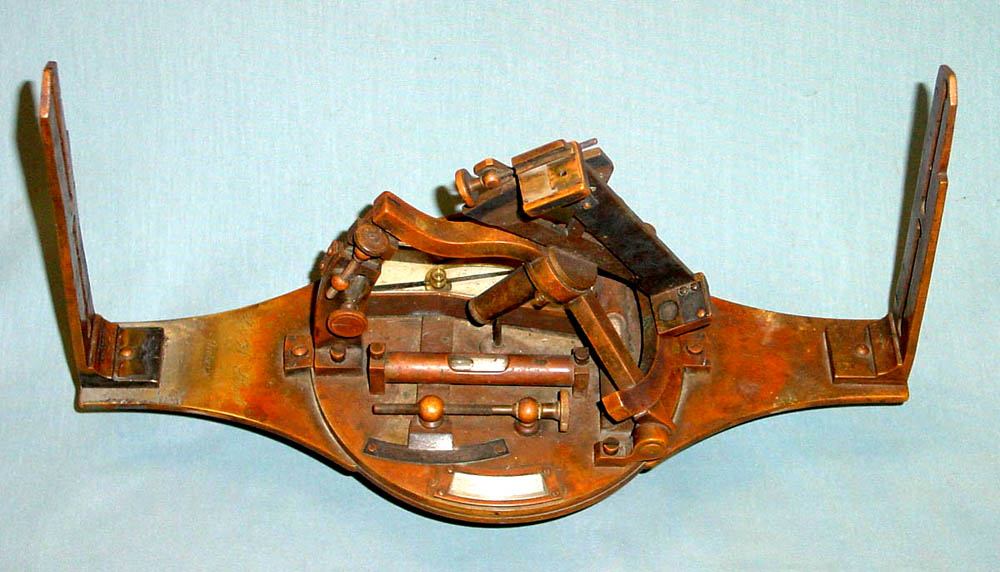BURT'S IMPROVED SOLAR COMPASS
made by the
SONS OF THE INVENTOR - WILLIAM AUSTIN BURT
A once-in-a-lifetime opportunity to own a historic one-of-a-kind instrument.
Made by John and William Burt
Detroit, Michigan
1856-57
SOLD

SOLD
History
The Burt's Improved Solar Compass has long been considered by collectors to be the pinnacle among 19th century American surveying instruments. Part of this is because of its great scarcity and partly because of the unique mechanism for locating true north by the position of the sun. It was also the government prescribed instrument for surveying the public lands of the United States.
The solar compass was invented by a gifted craftsman and surveyor, William A. Burt, who in 1829 also invented America's first typewriter. Burt experienced trouble while surveying iron-bearing government land in Michigan with his conventional needle compass, so began working on an instrument that would not be hindered by the presence of ferrous deposits. He received a patent for the solar compass in 1836, and the first ones were produced by the noted instrument maker – William J. Young of Philadelphia.
The compass offered here was made 20 years later by his sons, John and William. A brief history of their manufacturing business follows:
In 1852 a Detroit instrument maker John Bailey received authorization to produce the Burt’s Patent Solar Compass. During the next year Bailey took in William Austin Burt’s sons, John and William, as partners, forming Burt & Bailey. When Bailey left in 1856 the surviving partnership became known as J & W Burt. This business lasted one year and the next venture was Burt and Watson which continued for another year.
All available records that list or offer antique surveying instruments, including dealer catalogs and published books and articles were consulted for surviving instruments by the firm J & W Burt. As far as is known, this is the only surviving instrument by the two sons of William Austin Burt. It seems ironic that the only remaining example of their business is a Burt's Improved Solar Compass.
The instrument has not been cleaned and is offered as-found condition. The mechanical condition has been examined and appears sound. All mechanisms turn with no problems encountered. The clamping and adjusting knobs are all present and the level vials intact with proper amounts of fluid. Both vials appear to be original with no graduation lines.
Another big plus for the serious collectors is the presence of the adjusting bar in the unlikely event that someone wants to try some solar pointings. Also rather unique are the unusual sliding sun shades that reduce the amount of light passing through the tiny solar lenses. Most solar compasses have circular swing-away shades.
The surface finish is uneven with varying shades of patina. Some collectors prefer the way it is as being more representative of its heritage while others may consider having a professional surface restoration. This is one of those items that whichever way the new owner chooses to go won't be wrong because it is such a fine instrument. The tendency is for serious instrument collectors not to refinish, while owners wanting a more attractive appearance might go for refinishing.
The mahogany case is not original, rather being one made for the solar compass instrument by the noted firm of W. & L.E. Gurley of Troy, N.Y.
The instrument lacks both the leveling base and tripod. Like with needle compasses, the leveling base sometimes gets left on the tripod and eventually becomes separated from the instrument.
A slight inward bending of the sight vanes can be noticed when viewed directly from the side. More severe bending of sight vanes can result from a fall but that is not the case here. The brass base plate is straight, so it seems that the vanes may have eventually taken a bend by their being pressed inwards as the instrument is lowered into the case. Also, one of the sights has some bruising and a black-colored surface at the base.
A combination of factors support a hypothesis that there was once a telescopic attachment to the instrument. That type of accessory is not uncommon on solar compasses. The bases for this are (1) the 4 empty screw holes on the underside of the instrument, (2) the strange cutout to the upper portion of the sights where the telescope bracket may have attached, and (3) the inside of the case that has the impression of the end of a telescope and a non-Gurley brass bar that was used to mount an accessory such as a telescope. The 4 holes may have been for something other than a telescope but no other accessory comes to mind.
One of the glass coverings for the scale windows is gone and was replaced by some old celluloid. The other window appears to have the original glass.
Please send an email if you have a question.
|